Sewer pipe cleaning: a discussion of the best ways to clean pipes from blockages
There are several reasons why blockages form in sewer pipes: improper installation, careless operation of the sewer system, old pipes. But the consequences are always the same - there is a cork that makes it difficult for the normal movement of wastewater.
In this case, urgent cleaning of sewer pipes is needed. Next, we will explain in detail what tools and technologies will be required.
The content of the article:
3 signs of sewage problems
If no gratings are installed on the drain holes of the sinks, household waste gets into the siphons and pipes, and fat settles on the walls. Sooner or later, the thickness of the layer becomes such that the dirt interferes with the free passage of the liquid and any solid particles can plug the pipes tightly.
There are several signs by which you can identify problems in the system:
- Sewer stink. The waste accumulating on the walls of the pipes emits a characteristic unpleasant odor. It enters the room and poisons the air. If appeared smell from the sink sinks or baths should be taken as soon as possible.
- Slow discharge of water. If the fluid does not leave well, it means that too much deposits have accumulated on the pipe walls. It's time to remove them. Often, just pouring a bucket of boiling water into the sink is enough for this. The fat will dissolve and go further down the drain.
- Complete stop of the device. If the water has completely stopped draining into the sewer system, it's time to take up the plumbing cable, because half measures are not enough, and special chemistry is unlikely to be effective.
Most often, food waste, hair, grease and dissolved detergents clog the sewer. Such traffic jams can liquidate yourselfwithout the help of plumbers with special tools.
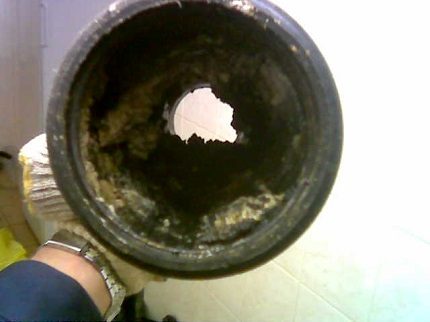

If the blockage completely blocks the pipes, water begins to accumulate in the sink or bathtub, overflowing. This may result not only in the cost of plumbing services, but also a full repair of the bathroom.
It is not necessary to bring the system to such a state, it is better to immediately respond to the "first calls". It's cheaper.
Mechanical and chemical pipe cleaning
If a blockage occurs due to a solid object entering the system, specialists will have to be invited to clean the sewer pipes. They use their own tools and equipment - long high-strength cables and special machines, including pneumatic, drilling, root cutting.
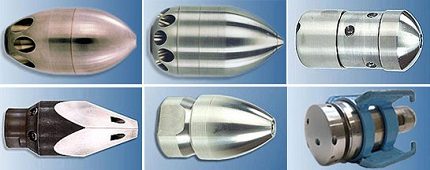
Less serious blockages can be eliminated independently - with the help of cables, plungers, special household chemicals for cleaning the sewer. The most reliable device that can cope with almost any traffic jam is a plumbing cable.
It saves in situations where other means are useless. But simple blockages can be eliminated with the help of plungers or chemistry.
Option 1: plumbing cable
It is a versatile sewer cleaning tool. It is made of metal spring. Due to the large length of the cable, it can be difficult to hold and turn it, so manufacturers pay attention to the handles of their models. Nozzles are fixed on the working part of the cable, thanks to which any dirt plugs can be destroyed.
When choosing a tool, the following criteria are of fundamental importance:
- Diameter. It is selected depending on the diameter of the sewer pipes.
- Length. The variety of models is huge. Their length can range from 2-3 to 45-60 m. It is necessary to determine the purpose of use and choose the most convenient tool.
- View. There are several types of models. To choose the right one, you should consider the features of the sewer system.
- Strength.When choosing a cable, special attention is paid to quality. Savings here are not appropriate, because a good tool will last several decades.
- Material. It is better to give preference to thick galvanized steel, especially if you plan to buy a spring model. Weak springs often straighten, which makes their operation difficult.
- Pen shape. The handle of the cable should fit snugly in the palm of your hand, because you will have to make efforts to turn the tool in the pipe. For long cables, the ideal shape is a curved shaft. It is best that the handle slides over the instrument and can be locked in any convenient place.
In addition to traditional mechanical cables, there are also electric ones. The principle of their work is the same: the tool is pushed into sewer pipes and with its help they destroy the blockage. The difference lies in the fact that they push the cable into the pipe not manually, but using an electric drive.
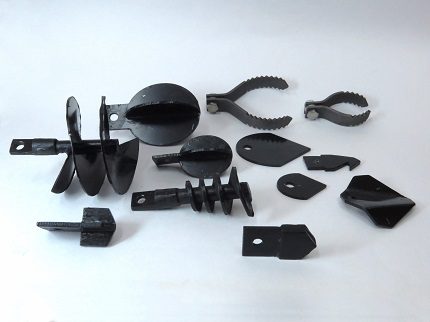
The electric cable is not difficult to operate. To figure out how to properly clean the sewer pipe, just read the instructions.
When the tool nozzle reaches the plug, you need to change the speed of the trigger mechanism to effectively destroy deposits and not damage the elements of the system. Around the same principle, special plumbing machines work.
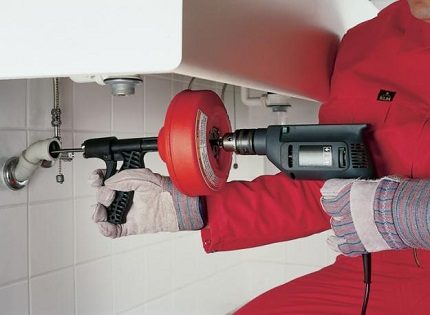
The technology for cleaning pipes with a cable is the same regardless of the type of tool:
- Inspection. Before starting work, you should inspect the plumbing tool, make sure that there are no serious damage and the reliability of the handle fastening. This is important because if the cable or part of it comes off during cleaning, the situation will only get worse, and a normal blockage will seem a trifle in comparison with the need to extract a smooth metal tool from the pipe.
- Training. It is necessary to select the correct nozzle and fix it firmly on the end of the cable. If the same fixed attachment is used, make sure that it is well fixed and not damaged. If necessary, lubricate the sleeve bushings.
- Pipe cleaning. If a blockage forms in the sink, the siphon should be removed so as not to damage it. If possible, remove all plastic parts. After that, the end of the cable is inserted into the pipe, cranked, gradually pushing deeper. Sometimes it is necessary to take out a tool, clean it and again push it further down the drain.
- Blockage. When the tool bumps into an obstacle, you need to reduce the rotation speed, make sure that it is a blockage, and not turn the pipe, and quickly break the cork with quick, gentle movements. If possible, it’s best to hook the blockage and pull it out. If not, push forward.
- Shutdown. When patency of the pipe is restored, rinse it with hot water. This will help get rid of grease and dirt in the system. First, the valve is opened only a little, and then the pressure is increased to a maximum. The main thing is that water flows freely through the drain.
An important sign that everything is done correctly is the swirl of water when draining into the drain. If a funnel forms, it means the pipe walls are clean and smooth. If the water leaves weakly, you should repeat the cleaning with a cable, and after it, wash the sewer with boiling water, special chemistry, soda or citric acid.
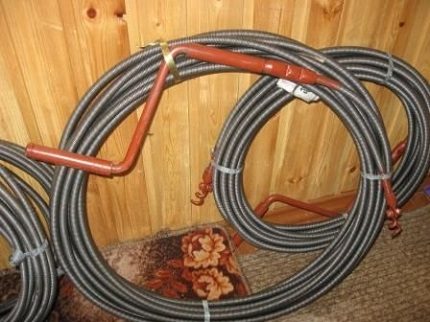
To Work with plumbing cable uncomplicated, but sometimes there are troubles. If the pressure is too strong, there is a risk of breaking through the plastic pipe or damaging any element of the system. Therefore, you need to act carefully: it’s better to “squeeze” than to “squeeze”.
If the tool gets stuck while pushing forward, sharp movements are generally excluded: you must slowly “shake” it from side to side until the pressure is released.
Option 2: plunger and its analogues
Many are interested in how to clean a simple blockage in the pipe if there is no cable? You can try to cope with a cork with a plunger. The tool consists of a rubber or silicone cap and a handle.
Its advantages:
- Versatility. It can be used for any plumbing fixtures.
- Safety. Plunger does not damage plastic. Unlike a cable, there is no risk that the working part of the tool comes off the handle and remains inside the pipe.
- Practicality. The device is easy to wash, dry and use.
- Compactness. The plunger takes up a minimum of space. There are collapsible models that are even more convenient to store.
- Cheapness. A mechanical plunger is cheap compared to a metal cable, plumbing wire or tape.
The principle of operation of the device is based on the creation of the effect of water hammer, which occurs during translational movements of the device. This allows you to move the plug blockage, destroy it and move it further down the pipe.
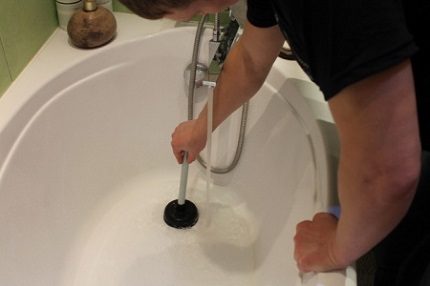
Although the use of plungers is almost not limited to anything, it is worth buying separate appliances for sinks and toilets. This will allow you not to worry about compliance with hygiene standards and even save a little.
It is not necessary to buy two expensive models, because a device of the most modest size is enough to clean the sink drain. But for the toilet it is better to choose a plunger with a large rubber cap.
In the absence of a toilet plunger, it can be replaced with improvised means, if the blockage is not very far along the pipe. A good alternative is plastic bottle volume of 1.5-2 liters.Dimensions should be selected depending on the diameter of the toilet.
The bottom of the bottle is cut off and used in the same way as a plunger, pumping water up and down. Water hammer will destroy the blockage, and the water will go down the drain.
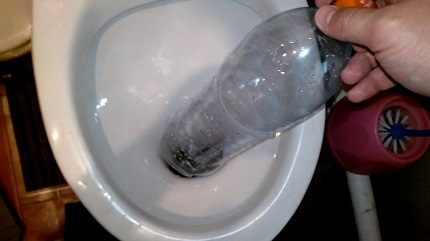
With a clogged toilet instead of a plunger, even an ordinary rag or a familiar brush brush is sometimes used. Of particular note is the Chinese (it is also called Korean) film.
If the other methods are ineffective against serious traffic jams, then with the help of a film it is possible to clean the toilet pipes very qualitatively, because high pressure is created and a powerful stream of water tears dirt from the inner walls.
Option 3: soda and special chemistry
Dry cleaning of sewers has one, but a big drawback: it cannot be used with tight blockage of pipes. This also applies to store products, and traditional soda.
If the sewage system is clogged tightly, and there is water in the sink, bathtub or toilet bowl, pouring or pouring in any chemistry is useless, because it will not get clogged or the concentration will be insufficient.
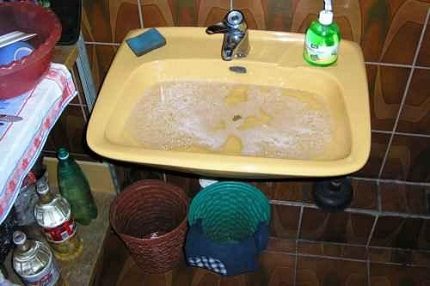
Some owners decide to remove the siphon, drain the water and pour chemicals directly into the sewer. This may work, but it’s better to use a cable because probability of success is higher.
Chemistry is better for sure. It is effective if the blockage is simple, is relatively close to the drain, and the water, although weak, but passes through the pipe.
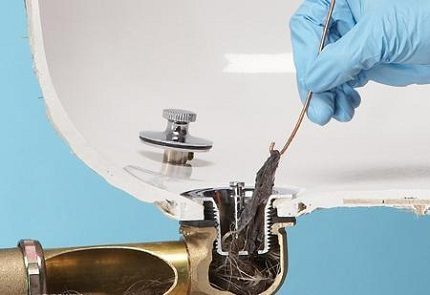
When choosing chemicals pay attention to the composition and purpose. Acid-based products are more appropriate in the kitchen, as break down fats best.
And for a bath and toilet, it makes sense to choose an alkaline product that copes well with soap residues, dissolves hair and coat.
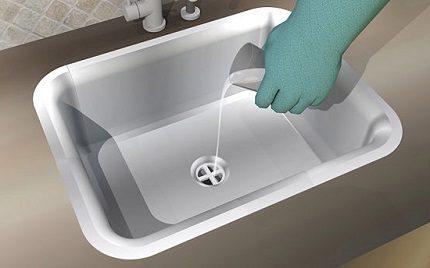
The release form also matters. Powder and granular formulations are considered more aggressive and care should be taken when using them.
Liquid and gel products are safer for plastic pipes. However, do not relax and leave them all night, because an increase in the duration of action does not at all guarantee an improvement in the result, but can damage it.

Chemistry is a simple but dangerous method of dealing with blockages. Aggressive substances enter the sewer, and then into the environment. In addition, fumes can cause allergies, provoke respiratory diseases.
It is better to choose an environmentally friendly composition - baking soda (can be combined with vinegar or salt).

Consider how you can clean the sewer pipe with soda and remove deposits from the walls:
- Pour half a pack of baking soda into the drain, fill it with a glass of white vinegar and plug the hole with a rag.
- A violent chemical reaction should begin. You should wait for it to finish.
- When the composition stops hissing and foaming, you can get a rag and spill pipes with hot water.
This method is simple, suitable not only for controlling blockages, but also for prevention.
Conclusions and useful video on the topic
Cleaning methods for sewer pipes are not limited to those listed. There are many other ways that can be successfully applied in your home. We offer the most interesting materials on the topic.
An overview of popular ways to clean blockages:
Special wire rope heads are sold in stores, but you can make them yourself if you use the following tips:
The plunger is able to save in the most unpleasant situations. How to use it is described below:
There are interesting folk recipes on how to make a caustic solution from soda, which is not inferior in effectiveness to purchased products. We offer step-by-step video instructions:
All methods for cleaning sewer pipes are good in their own way. It is worth choosing one or more suitable agents and use as necessary. Do not forget about preventive measures: watch what gets into the sewer, use drainage nets and regularly flush pipes with soda or chemicals.
Clean sewage is the key to a comfortable life.
Do you know other effective ways to clean the sewer and use them successfully? Or, perhaps, have found flaws in the material presented or want to ask a question on the topic of the article? Please write your comments in the box below.

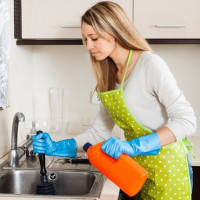 Sewerage flushing: pipe cleaning methods + main causes of blockages
Sewerage flushing: pipe cleaning methods + main causes of blockages  How to choose a tool for cleaning sewer pipes: a comparative overview of all types of tools
How to choose a tool for cleaning sewer pipes: a comparative overview of all types of tools 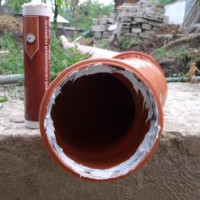 Sealant for sewer pipes: types, manufacturers overview, which are better and why
Sealant for sewer pipes: types, manufacturers overview, which are better and why 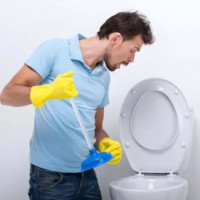 The smell of sewage in the toilet: an overview of the possible causes and solutions
The smell of sewage in the toilet: an overview of the possible causes and solutions 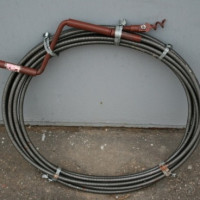 Sewer cleaning cable: types of tools and how to use them correctly
Sewer cleaning cable: types of tools and how to use them correctly 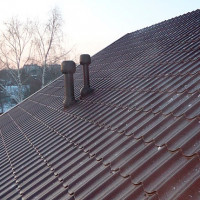 How to mount a fan pipe: step-by-step instruction and analysis of common mistakes
How to mount a fan pipe: step-by-step instruction and analysis of common mistakes  How much does it cost to connect gas to a private house: the price of organizing gas supply
How much does it cost to connect gas to a private house: the price of organizing gas supply  The best washing machines with dryer: model rating and customer tips
The best washing machines with dryer: model rating and customer tips  What is the color temperature of light and the nuances of choosing the temperature of the lamps to suit your needs
What is the color temperature of light and the nuances of choosing the temperature of the lamps to suit your needs  Replacement of a geyser in an apartment: replacement paperwork + basic norms and requirements
Replacement of a geyser in an apartment: replacement paperwork + basic norms and requirements
Initially, when installing the sewage system, it is necessary to use pipes of a slightly larger diameter and make the design slopes steeper. Then they will clog once every 25 years. And for cleaning, there is nothing better than a cable and a brush. Chemistry is nonsense, not worthy of attention. Well, the best option: every five to ten years to dismantle the system and clean the pipes. Moreover, modern designs of plastic pipes and fittings allow you to do this quickly.
And do you know a lot of people who, for the sake of prevention, take apart pipes and clean them? While the blockage is tight, no one will do it.
By and large, this is happening, no preventive work and preventive measures, only a blockage that makes you act! Alas, many people do this. But on the account of preventive cleaning and washing of risers, then I do not agree with you.
This should be done by the relevant representatives of the Criminal Code of an apartment building. This should be clearly stated in the contract. And this is regulated by the rules and norms of the technical operation of the housing stock.
Sewer risers should be cleaned and flushed at least once a year. In addition, acts on the implementation of the relevant work should be filled out and signed.
These are the collective farmers who will advise and stick more and cooler. Everything has its own dimensions and requirements. Taken, by the way, not from the ceiling, but technically sound.When everything is done fine, for private use it lasts for decades. And some in five, and someone in a year, cleans and thinks that this is normal. Well, like a sewer.
I will tell you from my bitter experience, there is a problem, call the plumbing with normal equipment. Decides faster and more reliable. I had a story, a pipe clogged in the kitchen, I began to clean it myself, it seemed like a blockage had passed, again a day later, then no matter how. Moreover, water from the neighbors from above came to me. That is, the blockage was not only in me, but also in the main pipe. Total, flooded the kitchen. I won’t talk about communication with the management company, it’s empty. I tried to solve it myself. In apartment buildings, this, by the way, is tin. To engage in the boner, you need to collect all the neighbors around the boner. To monitor the water at home during the work. Then he called the public utilities. They eliminated with a mechanical cable, attention, in 12 minutes! If I had called before, I would have saved a lot of nerves and time! There is a problem, the door to her professional!